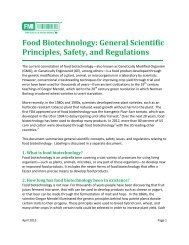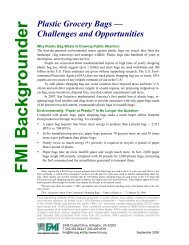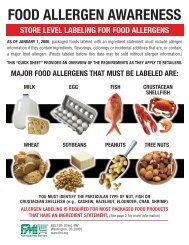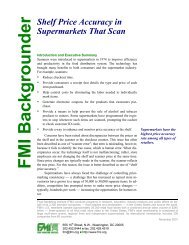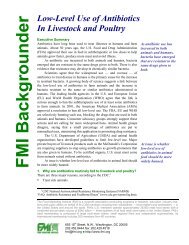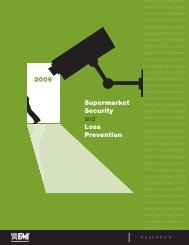Untitled - Food Marketing Institute
Untitled - Food Marketing Institute
Untitled - Food Marketing Institute
You also want an ePaper? Increase the reach of your titles
YUMPU automatically turns print PDFs into web optimized ePapers that Google loves.
or taxi cab options available, it can be highly inconvenient to transport large<br />
quantities of groceries by public transportation and expensive to do so by taxi.<br />
The absence of supermarkets in underserved areas is thought to affect the health,<br />
economy and social well-being of people living in that region. For example,<br />
observational studies have associated low access to healthier foods with higher<br />
obesity and disease rates. (It should be noted that two-thirds of Americans are<br />
overweight and most have high access to grocery stores). Both food insecurity and<br />
easy access to food have been linked with higher obesity rates, regardless of the<br />
food’s source (ERS 2009). There are few studies of food intake before and after<br />
grocery stores become available. The few studies that have been conducted show<br />
only a small increase in fruits and vegetables consumption. Consumption of<br />
healthier foods (e.g., fruits, vegetables, low-fat dairy or whole grains) will not<br />
reduce obesity without changes in other eating behaviors (e.g., consuming fewer<br />
calories) (ERS 2009). Clearly, there are no guarantees that simply providing access<br />
to healthier foods changes people’s eating habits; additional steps are required to<br />
change behaviors.<br />
There are economic costs to neighborhoods that lack grocery stores as well. <strong>Food</strong>s<br />
available through corner markets are usually more expensive, and travel costs in<br />
both time and money to distant grocery stores can be higher. Also, neighborhoods<br />
without grocery stores have fewer local job opportunities. The average<br />
supermarket hires 90 people or more directly from the areas where they operate.<br />
This can be a huge benefit in urban and rural areas with lower levels of economic<br />
development.<br />
Socially, supermarkets can directly impact their neighborhoods as well because<br />
economic development can reduce poverty and crime, attracting additional<br />
businesses to the area.<br />
Barriers to Grocery Store Development in Low Access Areas<br />
Inadequate Demographic Base<br />
Most grocery retail chains have well-defined store formats that they have developed<br />
to successfully serve a certain number of customers and achieve profitable sales<br />
volumes. Depending on competition from other types of grocery outlets in the<br />
area, attracting a sufficient customer base to successfully sustain a grocery store<br />
can be challenging. Typically, grocery chains look for areas capable of supporting<br />
their format rather than redeveloping their store concepts to fit a particular<br />
Access to Healthier <strong>Food</strong>s: Opportunities and Challenges for <strong>Food</strong> Retailers in Underserved Areas<br />
5




